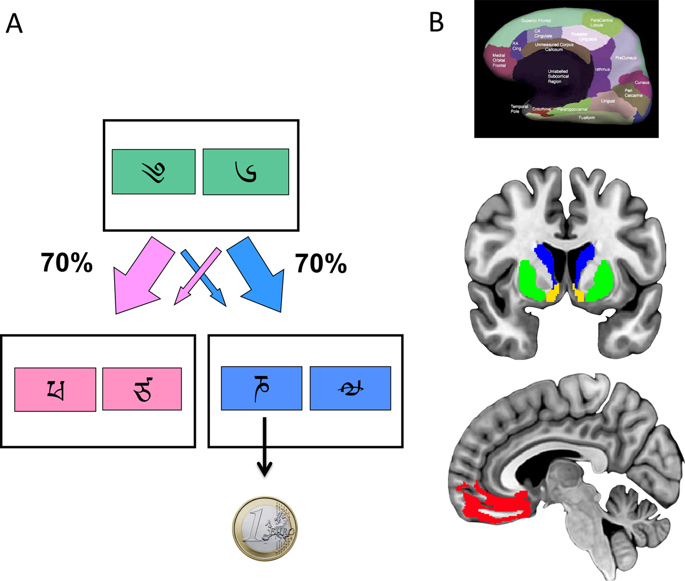当前位置:
X-MOL 学术
›
Transl. Psychiaty
›
论文详情
Our official English website, www.x-mol.net, welcomes your
feedback! (Note: you will need to create a separate account there.)
The neurochemical substrates of habitual and goal-directed control.
Translational Psychiatry ( IF 5.8 ) Pub Date : 2020-03-03 , DOI: 10.1038/s41398-020-0762-5 Valerie Voon 1, 2, 3 , Juho Joutsa 4, 5, 6, 7 , Joonas Majuri 4, 6 , Kwangyeol Baek 1, 8 , Camilla L Nord 1, 9 , Eveliina Arponen 6 , Sarita Forsback 6 , Valtteri Kaasinen 4, 7
Translational Psychiatry ( IF 5.8 ) Pub Date : 2020-03-03 , DOI: 10.1038/s41398-020-0762-5 Valerie Voon 1, 2, 3 , Juho Joutsa 4, 5, 6, 7 , Joonas Majuri 4, 6 , Kwangyeol Baek 1, 8 , Camilla L Nord 1, 9 , Eveliina Arponen 6 , Sarita Forsback 6 , Valtteri Kaasinen 4, 7
Affiliation

|
Our daily decisions are governed by the arbitration between goal-directed and habitual strategies. However, the neurochemical basis of this arbitration is unclear. We assessed the contribution of dopaminergic, serotonergic, and opioidergic systems to this balance across reward and loss domains. Thirty-nine participants (17 healthy controls, 15 patients with pathological gambling, and 7 with binge eating disorder) underwent positron emission tomography (PET) imaging with [18F]FDOPA, [11C]MADAM and [11C]carfentanil to assess presynaptic dopamine, and serotonin transporter and mu-opioid receptor binding potential. Separately, participants completed a modified two-step task, which quantifies the degree to which decision-making is influenced by goal-directed or habitual strategies. All participants completed a version with reward outcomes; healthy controls additionally completed a version with loss outcomes. In the context of rewarding outcomes, we found that greater serotonin transporter binding potential in prefrontal regions was associated with habitual control, while greater serotonin transporter binding potential in the putamen was marginally associated with goal-directed control; however, the findings were no longer significant when controlling for the opposing valence (loss). In blocks with loss outcomes, we found that the opioidergic system, specifically greater [11C]carfentanil binding potential, was positively associated with goal-directed control and negatively associated with habit-directed control. Our findings illuminate the complex neurochemical basis of goal-directed and habitual behavior, implicating differential roles for prefrontal and subcortical serotonin in decision-making across healthy and pathological populations.
中文翻译:

习惯性控制和目标控制的神经化学物质。
我们的日常决策受目标导向和习惯策略之间的仲裁约束。但是,这种仲裁的神经化学基础尚不清楚。我们评估了多巴胺能,血清素能和卵磷脂系统对奖励和损失领域中这种平衡的贡献。三十九名参与者(17名健康对照者,15名病理性赌博患者和7名暴食症患者)接受了[18F] FDOPA,[11C] MADAM和[11C]卡芬太尼的正电子发射断层扫描(PET)成像,以评估突触前多巴胺,与血清素转运蛋白和μ阿片受体的结合潜力。参与者分别完成了一个修改后的两步任务,该任务量化了决策受目标导向或惯用策略影响的程度。所有参与者都完成了带有奖励结果的版本;健康对照者还完成了一个带有损失结果的版本。在有意义的结果中,我们发现前额叶区域中更大的血清素转运蛋白结合潜力与习惯性控制相关,而壳核中更大的血清素转运蛋白结合潜力与目标导向的控制相关。但是,控制相对价(损失)时,发现不再重要。在具有损失结局的区块中,我们发现,阿片体能系统,特别是更大的[11C]卡芬太尼结合潜力,与目标导向的控制呈正相关,与习惯导向的控制呈负相关。我们的发现阐明了目标导向和习惯行为的复杂神经化学基础,
更新日期:2020-03-03
中文翻译:

习惯性控制和目标控制的神经化学物质。
我们的日常决策受目标导向和习惯策略之间的仲裁约束。但是,这种仲裁的神经化学基础尚不清楚。我们评估了多巴胺能,血清素能和卵磷脂系统对奖励和损失领域中这种平衡的贡献。三十九名参与者(17名健康对照者,15名病理性赌博患者和7名暴食症患者)接受了[18F] FDOPA,[11C] MADAM和[11C]卡芬太尼的正电子发射断层扫描(PET)成像,以评估突触前多巴胺,与血清素转运蛋白和μ阿片受体的结合潜力。参与者分别完成了一个修改后的两步任务,该任务量化了决策受目标导向或惯用策略影响的程度。所有参与者都完成了带有奖励结果的版本;健康对照者还完成了一个带有损失结果的版本。在有意义的结果中,我们发现前额叶区域中更大的血清素转运蛋白结合潜力与习惯性控制相关,而壳核中更大的血清素转运蛋白结合潜力与目标导向的控制相关。但是,控制相对价(损失)时,发现不再重要。在具有损失结局的区块中,我们发现,阿片体能系统,特别是更大的[11C]卡芬太尼结合潜力,与目标导向的控制呈正相关,与习惯导向的控制呈负相关。我们的发现阐明了目标导向和习惯行为的复杂神经化学基础,











































 京公网安备 11010802027423号
京公网安备 11010802027423号